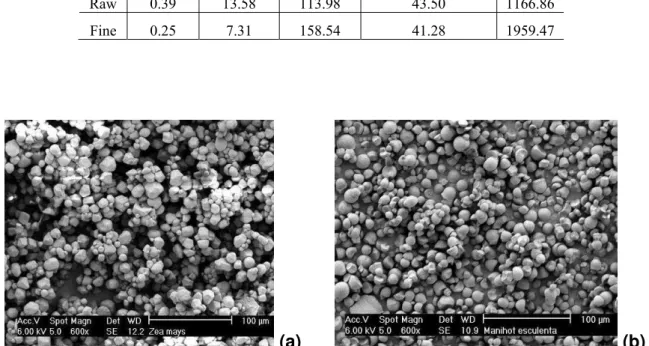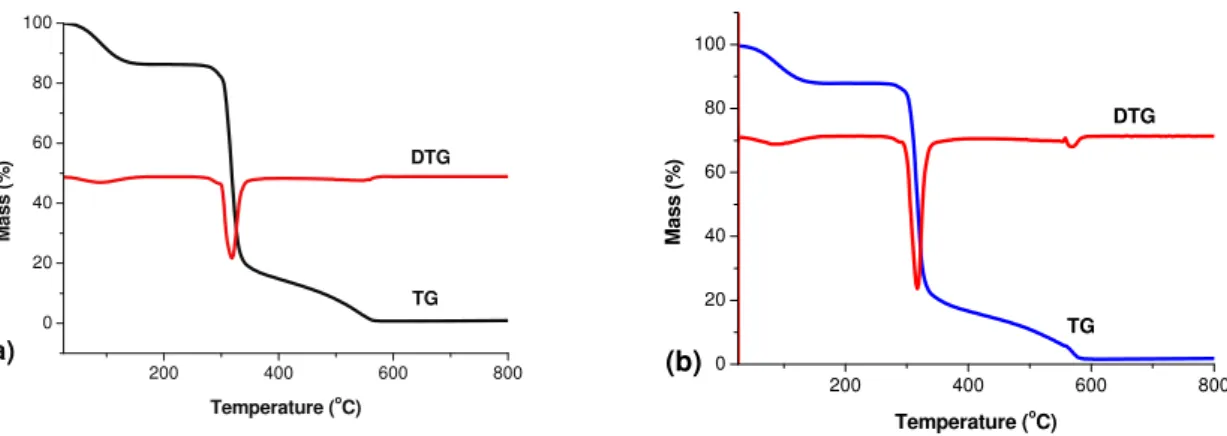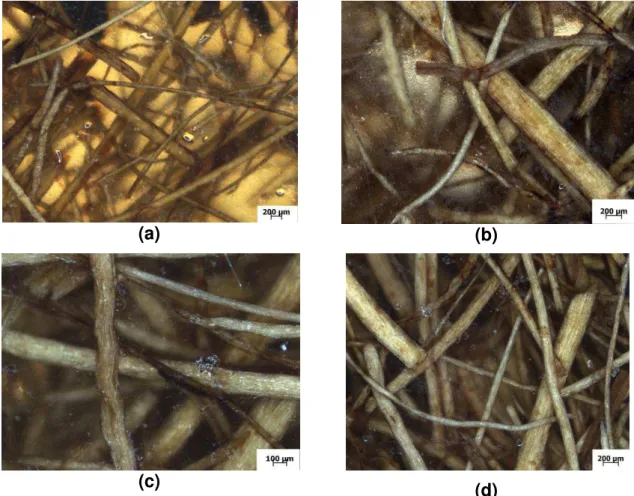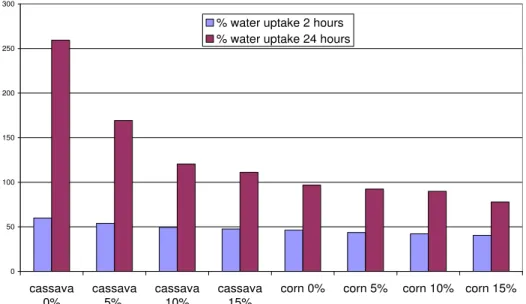ISSN 1 5 1 7 - 7 0 7 6
Revista Matéria, v. 15, n. 2, pp. 330-337, 2010. http://www.materia.coppe.ufrj.br/sarra/artigos/artigo11236
Preparation and characterization of biodegradable composites based on
brazilian cassava starch, corn starch and green coconut fibers
María Guadalupe Lomelí Ramírez; Graciela I. Bolzon de. Muniz; Kestur G. Satyanarayana; Valcineide Tanobe; Setsuo Iwakiri
Universidade Federal do Paraná. Centro de Ciências Florestais e da Madeira. Av. Pref. Lothário Meissner, 900. Curitiba, Paraná, Brazil.
e-mail: glomeli12@hotmail.com ; kgs_satya@yahoo.co.in ; valcy@demec.ufpr.br
ABSTRACT
Increasing search for new materials with high premium on eco-friendliness, new trend is emerging in materials development such as composites, which are well established for a wide variety of applications. With growing interest and importance of renewable bioresources has led to more stress on the use of locally available materials. This paper presents preliminary results on the preparation and characterization of composites based on Brazilian coconut fibers and starches of cassava and corn. The raw materials were characterized for their morphology, chemical composition, and thermal properties and X-ray diffraction studies. Coir fibers were also tested for their tensile properties showing increasing strength and Young`s modulus with decreasing diameter, while the % elongation remaining constant. Lignin content of coir was found to be 35%. Structure and properties of composites containing 0, 5 10, 15% fibers in both the matrices and prepared by compression molding would be compared. For the 2 types of starch, there was an increase in the tensile strength by the increasing proportion of fiber. The effect of moisture in the composite stress affects the strength and percentage elongation. The water absorption was higher in the composites made from cassava starch.
Keywords: Cassava starch, corn starch, coconut fiber, glycerol.
1 INTRODUCTION
It is well known that plastic materials are very versatile materials with wide range of applications and hence their production and consumption have been increasing. However, most of these are synthetic materials and hence inert to attack by microorganisms and therefore pose environmental problem in their disposal [1]. In view of this, investigations have been directed to find eco-friendly materials, which are recyclable or biodegradable. Such materials are made of natural materials, while biodegradable composites will have biodegradable matrix and reinforcements as their constituents. A number of polymeric materials (natural resins or synthetic resins), which are biodegradable, is available. One such natural resin is starch, which is normally made into thermoplastic by processing using several industrial techniques as injection, extrusion or the use of a batch mixer [2] connected to a torque rheometer. Unfortunately this type of material has the problem of absorption of humidity and it exhibits inferior mechanical properties compared to the synthetic plastic materials [3]. This has been overcome by incorporating lignocellulosic fibers such as coir fibers into the natural resin matrices, since these provide big advantage over the synthetic fibers such as light weight, low cost, non-abrasiveness, etc.
In recent years Brazil has been in the forefront for the use of industrial residuals. One such material available here is the fiber resulting from discards of the green coconut, which is a very important option in the northeast of Brazil. On the other hand, Brazil is the principal Latin American country that presents the highest production and yield per hectare in the production of cassava starch.
2 MATERIALS AND METHODS
Native cassava starch used (Manihot esculenta), was donated by the J. A. Pasquini & Cía. Ltda. (Brazil) and corn starch (Zea mays) by Corn Products Brazil (Amidex 3001). The coconut fiber from green coconuts (Cocos nucifera) was donated by the COOBCOCO Company in the Northeast of Brazil. Commercial glycerin was used as plasticizer. Chemical composition of fiber was determined by Tappi and NBR standards. Thermal analysis (TGA) of both the fiber and the starch were determined using NETZSCH thermogravimetric balance, (model TG – 209).
The fibers of green coconut were dried, milled and sorted to obtain fiber sof 10 mm size. Different amounts of coconut fibers (0, 5 10 and 15 wt. %) and 30% of glycerin were used to prepare the composites using mold of size 17 cm2 and thickness of 3 mm, compression molded using a hydraulic press with hot pressing facility (Solab) applying 8 tons of pressure. From the laminates thus obtained, tensile specimens were made with specimen size as peer ASTM standard D 638M-93 [4]. While the coir fibers were tensile tested using INSTRON 4467 universal testing machine, their starch composites were tested using EMIC DL-2000 universal testing machine. The composites were tested at two different humidity (6-7% and with 3-4%). Crystallinity of both the fiber and the starch was determined by X-ray diffraction using Shimadzu machine model: XRD 7000, adjusted with a scanning speed of 1o/min with copper radiation at 40kV and 20 A.
Morphology of the fibers and starch was examined using Olympus (CX410) optical microscope and PHILIPS XL-30 scanning electron microscope. A stereomicroscope Zeiss make, model: Discovery V12 was used to observe the distribution of fibers in the thermoplastic starch matrix.
Since it is well known that one of the problems of thermoplastic starch is its susceptibility to humidity, water absorption of both the composites and the matrices were determined after immersing them for 2 and 24 hours following [5] EN 317 standard.
3 RESULTS AND DISCUSSION
Table 1 shows chemical analysis of coir fibers used. It can be seen that lignin content obtained in this study are lower than those reported for similar fibers elsewhere [6]. This is understandable as due to variation of chemical composition of fibers depends on various factors such as locality, age, etc. [7]. Since fiber used in the present case is from green coconuts, it might have been less lignified.
Table 1: Chemical composition of green coconut fiber. Parameter Our work Reference(6)
(%) (%)
Ash 1.25 2.4
Solubility in cold water 4.16 Solubility in hot water 4.93 Solubility in sodium hydroxide 21.29 Solubility in ethanol-toluene 2.95
Total extracts 5.82 6.4
Lignin 35.46 32.8
Figure 1 shows the cross section of the coconut fiber. It is observed that the coconut fiber is multicellular with a central part called lacuna. The porous surface of the fiber is useful for a better interlocking between the fiber and the matrix [6, 8].
The density of coir fiber was found to be 1200 kg.m-3. Table 2 shows the results of tensile testing of fibers. It can be seen that coir fibers of 0.25 mm diameter exhibited higher tensile strength and Young`s modulus as expected (smaller diameter of fiber, higher is the strength) comparable to the values reported earlier fro similar fibers [9].
Figure 1: SEM of cross-sections of coconut fiber.
Table 2: Results of the tensile test of green coir fiber. Fiber Diameter
mm
Load max. (N)
Stress max (MPa)
Elongation at Break (%)
MOE (Young)
(MPa)
Raw 0.39 13.58 113.98 43.50 1166.86
Fine 0.25 7.31 158.54 41.28 1959.47
(a)
(b)
Figure 2: SEM of corn (a) and cassava starch (b) granules.
Figure 3 shows TG/DTA curves of the coir fiber. Three main degradation points can be seen, first one at 160 ºC corresponding to the mass loss due to loss of moisture and highly volatile materials, the second at 360 ºC due to decomposition of hemicelluloses and the final at 480 ºC to the decomposition of the lignin [12]. On the other hand, in the case of cassava starch (Fig. 4a), the first mass loss occurred between 30 and 180 ºC, with an endothermic peak at 100 oC due to the 13.73% of dehydration followed by second thermal decomposition occurring at an endothermic peak at 320 oC and another at 520 ºC, which corresponded to a mass loss of 71.45% and 14.03% respectively.
Figure 3: Thermal analysis (TG) curve obtained for green coir fibers.
200 400 600 800
0 20 40 60 80 100
(a)
DTG
M
a
ss (
%
)
Temperature (oC)
TG
200 400 600 800
0 20 40 60 80 100
(b)
DTG
M
ass
(
%
)
Temperature (oC)
TG
Figure 4: Thermal analysis (TG/DTG) curves obtained for cassava (a) and corn (b) starch.
Figure 5(a) shows XRD patterns of corn starch (Amidex 3001) sample used. Main diffraction peaks were at 2θvalues of 15.19, 17.23, 18.06, 19.9 and 23.04 which coincide with earlier reported by Guimarães et al. [13], who used the same type of starch. The main diffraction angles indicate the starch belongs to starch Type A, characteristic of the cereals [9]. In the case of the cassava starch (Fig. 5b), five main peaks are seen at different diffraction angles (2θ) of 15.19, 17, 23, 18.13, 20.10 and 23.10. These, according to Kawabata [14] and Schlemmer [15] correspond to a type A-b structure (also denominated as CA (C in the vicinity of the one A) having crystallinity of 90% of the A type and 10% of type B. Similar results were also reported by Biliaderis [16] and Lacerda [17]. The restructuring of starch grains during the plastificacion (glycerine, temperature and pressure) in the thermo forming process during compression caused changes in the crystallographic profile similar to that observed for the corn starch composite and that of cassava starch with 0% and 15% of coconut fiber.
Figure 6 (a&c) shows photographs of both corn starch-glycerol composite with 5 and 15% coir fibers while Figure 6 (b&d) show those of cassava starch-glycerol with 5 and 15 % coir fibers as observed under stereomicroscope. Random and uniform distribution of the coir fibers of different diameters in the transparent matrices of plasticized starches can be seen.
0 10 20 30 40 50 60 0
500 1000 1500 2000 2500 3000 3500 4000
Int
e
n
s
it
y (
u
.a.
)
Angle (2θ)
Corn Starch
Comp. 0% fiber
Comp. 15% fiber
0 10 20 30 40 50 60 0
500 1000 1500 2000 2500 3000 3500 4000 4500 5000 5500
Cassava starch
Comp. 0% fiber
In
ten
s
it
y
(
u
.a
.)
Angle (2θ)
Comp. 15% fiber
(a) (b)
Figure 5: X ray diffraction patterns of (a) corn starch and their composites, and (b) cassava starch and their composites (0%, 15% coir fiber).
(a)
(b)
(c)
(d)
Figure 6: Stereomicroscope photographs corn starch composite with (a) 5% and (c) 15% coir ; cassava starch composite with (b) 5% and (d) 15% coir fibers.
0 50 100 150 200 250 300
cassava 0%
cassava 5%
cassava 10%
cassava 15%
corn 0% corn 5% corn 10% corn 15%
% water uptake 2 hours % water uptake 24 hours
Figure 7: Water absorption of composites of corn and cassava starch immersed in water for 2 to 24 hours.
Table 3: Results of the tensile test of composites cassava starch and corn starch reinforcing with different amounts of coconut fibers.
Material Amount fibers %
Load Max. (N) Tensile Max. (MPa)
Elongation % Humidity 6-7%
Corn starch
0 34.44 0.89 145.57
5 63.73 1.94 49.92
10 105.53 2.88 22.11 15 118.41 3.31 16.65 Cassava
starch
0 50.77 1.56 210.33
5 74.44 2.26 62.16
10 107.83 3.38 30.05 15 124.52 3.51 24.01
Humidity 3-4%
Corn starch
0 234.38 7.56 38.46
5 248.70 7.81 8.39
10 255.37 8.08 7.79 15 266.91 8.13 6.82 Cassava
starch
0 112.68 3.24 111.92
5 176.55 5.71 6.43
10 235.37 7.68 6.16 15 300.40 9.34 5.93
On the other hand, these values were low at two different humidities. It can be seen that maximum load for break and tensile strength improved with the incorporation of coir fiber, which increased with increasing amount of fibers, while % elongation decreases significantly in both the composites at 6-7% humidity.
On the other hand, these values increased marginally for corn starch composites at 3-4% humidity, probably due to the rigidity of the matrix, while it was higher in the case of cassava starch composites at the same humidity. These results are in agreement with those reported elsewhere [3, 18].
4 CONCLUSIONS
Corn starch granules were of polyhedra or polygon shape with 28% amylose and 72% amilopectin, while those of cassava were globular with about 18% amylose and 82% amilopectin.
Composites of both corn starch and cassava starches reinforced with coir fibers could be prepared by thermo molding using glycerol as plasticizer, which resulted in random, but uniform distribution of fibers in transparent matrices. Both the maximum load for break and tensile strength improved with the incorporation of coir fibers into both the starches, which increased with increasing fiber content, while % elongation decreased significantly in both the composites at 6-7% humidity. Though these values increased marginally with corn starch composites at 3-4% humidity, they were higher in the case of cassava starch composites at the same humidity.
Also, cassava starch composites showed higher percentage of water absorption compared to that of corn starch composites. Similar tendency of decreasing water absorption with increasing fiber content was observed for both the composites.
5 ACKNOWLEDGEMENTS
Acknowledge Corn Products and Pasquini companies of Brazil for supplying the starch samples and COOBCOCO by coconut fibers. The authors acknowledge the financial support of CAPES through the agreement PEC-PG. Sincerely thank Felipe Zatt Schardosin for their help in the tensile testing of composites and chemical composition analysis.
6 REFERENCES
[1] SUGIH, A. K., “Synthesis and properties of starch based biomaterials”, Thesis doctoral, Rijksuniversiteit Groningen, pp. 143, 2008.
[2] CORRADINI, E., AGNELLI, J.A.M., MATTOSO, L.H.C., “Amido Termoplástico”, Embrapa Instrumentação Agropecuária, pp. 2, 2007.
[3] AVEROUS, L., LE DIGABEL, F., “Properties of biocomposites based on lignocellulosic fillers”,
Carbohydrate Polymers, v. 66, pp. 480-493, 2006.
[4] ASTM D 638M-93. Standard test method for tensile properties of plastics. Annual Book of ASTM Standards. Vol 10.01:pp 57-65, 1993.
[5] EN 317:1993. Particleboards and fibreboards. Determination of swelling in thickness after immersion in water.
[6] ABDUL KHALIL, H.P.S., SITI ALWANI, M., MOHD OMAR, A.K., “Chemical composition, anatomy, lignin distribution, an cell wall structure of Malaysian plant waste fibers”, BioResources, v. 1, n. 2, pp. 220-232, 2006.
[7] SATYANARAYANA, K.G., GUIMARÃES, J.L., WYPYCH, F.., “Studies on lignocellulosic fibers of Brazil. Part I - Source, production, morphology, properties and applications”, Composites Part A, v. 38, n. 8, pp. 1694-1709, 2007.
[8] SREEKALA, M.S., KUMARAN, M.G., THOMAS, S. “Oil palm fibers: Morphology, chemical composition, surface modification, and mechanical properties”, Journal of Applied Polymers Science, v. 66, pp. 821-835, 1997.
[9] FÁBIO, T., THAIS, H.D.S., SATYANARAYANA, K.G. “Studies on lignocellulosic fibers of Brazil: Part II- structure and properties of brazilian coconut fibers”, Composites Part A, v. 38, n. 8, pp.1710-1721, 2007.
[10] CEREDA M.P., (Coord.) “Culturas de tubersosas amiláceas latino americanas: propriedades gerais do amido”, Campinas: Fundação Cargill, pp. 221, 2001.
[12] SJOSTROM, E., “Wood chemistry: fundamentals and applications”, Academic Press, 2end Edition, San Diego, 1993
[13] GUIMARÃES, J.L., WYPYCH, F., SAUL, C.K., RAMOS, L.P., SATYANARAYANA, K.G., “Studies of the processing and characterization of corn starch and its composites with banana and sugarcane fibers from Brazil”, Carbohydrate Polymers, v. 80, pp. 130–138, 2010.
[14] KAWABATA, A., SAWAGARMA, S., NAGASHIMA, N., ROSARIA, R.R., NAKAMURA, M., J. Japan Society, Starch Science, v. 81, pp. 224, 1984.
[15] SCHLEMMER, D., “Preparação caracterização e degradação de blendas de poliestireno y amido termoplástico usando glicerol é óleo de Buriti (Mauritia flexuosa) como plastificates”, Tese de M.Sc.,Universidade de Brasilia, PP. 96, 2009.
[16] BILIADERIS, C. G., “Structures and phase transitions of starch in food systems, Food Technology, v. 46, pp. 98-109, 1992.
[17] LACERDA, L. G., “Uso de técnicas termoanalíticas na caracterização da hidrólise enzimática parcial de amidos de matérias-primas tropicais”, Dissertação de M.Sc., Universidade Estadual de Ponta Grossa, pp. 81, 2006.
![Table 1 shows chemical analysis of coir fibers used. It can be seen that lignin content obtained in this study are lower than those reported for similar fibers elsewhere [6]](https://thumb-eu.123doks.com/thumbv2/123dok_br/18872712.420546/2.892.274.642.686.877/table-chemical-analysis-fibers-content-obtained-reported-similar.webp)



